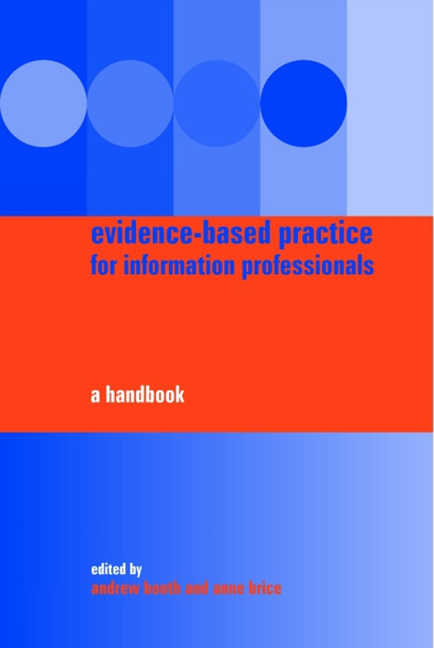Book contents
- Frontmatter
- Contents
- Foreword
- Editors and contributors
- Part 1 The context for evidence-based information practice
- 1 Why evidence-based information practice?
- 2 A brief history of evidence-based practice
- 3 Evidence-based information practice: a prehistory
- 4 How good is the evidence base?
- 5 Why don't librarians use research?
- Part 2 Skills and resources for evidence-based information practice
- Part 3 Using the evidence base in practice
- Index
1 - Why evidence-based information practice?
from Part 1 - The context for evidence-based information practice
Published online by Cambridge University Press: 08 June 2018
- Frontmatter
- Contents
- Foreword
- Editors and contributors
- Part 1 The context for evidence-based information practice
- 1 Why evidence-based information practice?
- 2 A brief history of evidence-based practice
- 3 Evidence-based information practice: a prehistory
- 4 How good is the evidence base?
- 5 Why don't librarians use research?
- Part 2 Skills and resources for evidence-based information practice
- Part 3 Using the evidence base in practice
- Index
Summary
Introduction
Evidence-based practice is rightly described as one of the ‘success stories of the 1990s’ (Trinder, 2000). Its growth in popularity is demonstrated by its spread from medicine to related health fields and, more importantly, by its migration to other disciplines and professions.
This chapter begins with a discussion of evidence-based practice, outlining the political and social context within which it has developed as a major part of public policy (Weiss, 1998; Nutbeam, 2001). It then moves to consider evidence-based information practice in particular, and concludes by discussing some of the strengths and weaknesses of the evidence-based practice paradigm as they apply to information practice.
Scenario
You are a member of a city-wide action group set up by the Education and Leisure Services to tackle concerns regarding the city's 14–16 year olds. There is an increasing perception that this age group is not being addressed by local facilities and amenities and, rightly or wrongly, this lack is being linked to a high prevalence of vandalism, drug use and teenage pregnancy. Working in a subgroup involving representatives of school, public, educational charity and further education college libraries, you are devising an action plan focusing on the specific contribution libraries might make.
You decide to look for evidence from the research literature to inform your decision making. A search on the internet, complemented by bibliographic databases,
identifies work funded by the UK organization Museums, Libraries and Archives Council (then Resource) as part of the ‘Start with the child’ initative. A research report reviews primary and secondary research and is usefully subdivided by age group. Each section models the child's world, then identifies the needs and motivations of that age group before outlining the implications for services.
On the basis of this evidence the subgroup devises an action plan which includes the following strategies:
• to provide a more welcoming atmosphere with a more sophisticated ambience and a variety of dedicated spaces – quiet, loud and chill-out
• to involve young people in the design and in staffing and interfacing
• to broaden content to reflect popular/contemporary/commercial culture, including music and fashion
• to allow young people to plug their own music into workspaces, through headphones and listening posts.
- Type
- Chapter
- Information
- Evidence-based Practice for Information ProfessionalsA Handbook, pp. 1 - 12Publisher: FacetPrint publication year: 2004
- 6
- Cited by



